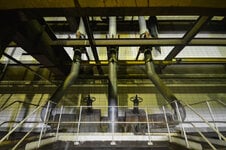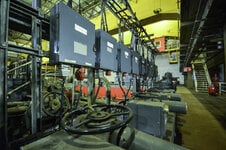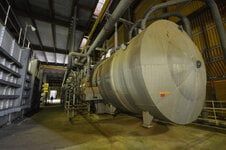History
Littlebrook D is one of four power stations located by the Dartford Crossing in Kent. A, B and C are decommissioned and D is in a mothballed state, the site is one of a number of stations throughout the UK with black-start capabilities, meaning that it is able to start generating without an external power supply - the station would be one of the first to start generating should the UK ever experience a partial or complete blackout. The 215 m (705 ft) tall chimney, is the fourth tallest chimney in the UK. It is an oil-fired power station and was built by the nationalised Central Electricity Generating Board and it generates enough power to meet the needs of over 2 million people. The station was built by the Cleveland Bridge Company with construction starting in 1976. The first unit commissioning underway by 1981. The 1980s still saw a potential threat from the Cold War, and as such the CEGB designed Littlebrook D as a robust station with high plant redundancy, meaning that the station would form a pivotal role should disaster have struck the city of London. At this time, London was still dependant on several smaller generating stations within the city itself. After privatisation in 1991, the station was owned by National Power, and later by its subsidivision Innogy. The station is currently owned by RWE nPower which is owned by the German utility company, RWE.
Littlebrook D played a vital role in restoring power supplies to the South East of England in the days following the storm force winds of October 1987. The black-start capability is facilitated by the presence of three open-cycle gas turbines (OCGTs), each capable of generating 35 MW, which is sufficient to operate the station auxiliary equipment and allow a main unit to be started. Each OCGT set incorporates two Rolls-Royce Olympus jet engines which are industrial derivatives of those that were used on the Concorde aircraft. As well as providing black-start supplies to the station, the fact that they can synchronise and ramp up to full load in under five minutes means they are used to generate at the request of National Grid Company (who operate the UK electricity grid system) to deal with short-term peaks in demand. Such peaks typically arise during the winter months, where evening demand is higher due to lighting and heating requirements.
A modification has been made to one of the units which allows for alternative fuel trials. Several have been trialled at the Littlebrook D site as part of ongoing research into generating energy from more sustainable fuel sources. At present, the current owners of the station have decided that Littlebrook is to "opt-out" under the Large Combustion Plant Directive, an EU directive aiming to deal with air pollutants created by the combustion of fossil fuels. This essentially means that Littlebrook D will cease to generate after 2015 in its current configuration, I believe it has recently been scheduled for March 2015.
The Explore
Visited this amazing site with extreme_ironing, our original intention was to just do a reccie but we got itchy feet due to access being so easy and there being no sign of security for more than 2 hours. In the end we just went for it and it was as easy as it looked although we were instantly shocked at how live the place seemed inside. We spent around 2 hours in there making it up onto the rooftop, the switch rooms, the turbine hall and a whole heap of other amazing stuff before we agreed not to push our luck and get the hell out of dodge. No sooner had we made that decision a face appeared from behind a door about 50 metres away from us and spotted us. This prompted a mad dash for the exit (we were about 8 floors up at this point), two 4X4 trucks screeched to a halt outside when we reached the ground floor so we had to think on our feet and quickly find ourselves a good hiding place. We made it outside and spent the next 4 hours cacking our pants, farting and playing I Spy. Security on walkie talkies walked straight past us numerous times talking about us, they were convinced we were still inside the building which was a relief to hear. We later poked our heads out after 3 hours when it seemed as though they'd given up but straight away saw someone with a walkie talkie patrolling just 10 metres away from us. We sat for another hour before making another dash for it, thankfully we didn't see a soul this time and made it out without any more drama. We were really lucky, anyway lesson learnt and I'm just glad we didn't get caught by the smell of my farts because that could've got us into a real stink....
The pics
I lost about 2 stone in sweat inside the electrical cupboard to get away with these so I hope you enjoy them! Thanks to extreme_ironing for having the patience to ride out the search, it was a stressful few hours with unknown consequences but we made it out without getting caught because of some quick thinking and a lorra lorra luck....


































Thanks for looking y'all
Littlebrook D is one of four power stations located by the Dartford Crossing in Kent. A, B and C are decommissioned and D is in a mothballed state, the site is one of a number of stations throughout the UK with black-start capabilities, meaning that it is able to start generating without an external power supply - the station would be one of the first to start generating should the UK ever experience a partial or complete blackout. The 215 m (705 ft) tall chimney, is the fourth tallest chimney in the UK. It is an oil-fired power station and was built by the nationalised Central Electricity Generating Board and it generates enough power to meet the needs of over 2 million people. The station was built by the Cleveland Bridge Company with construction starting in 1976. The first unit commissioning underway by 1981. The 1980s still saw a potential threat from the Cold War, and as such the CEGB designed Littlebrook D as a robust station with high plant redundancy, meaning that the station would form a pivotal role should disaster have struck the city of London. At this time, London was still dependant on several smaller generating stations within the city itself. After privatisation in 1991, the station was owned by National Power, and later by its subsidivision Innogy. The station is currently owned by RWE nPower which is owned by the German utility company, RWE.
Littlebrook D played a vital role in restoring power supplies to the South East of England in the days following the storm force winds of October 1987. The black-start capability is facilitated by the presence of three open-cycle gas turbines (OCGTs), each capable of generating 35 MW, which is sufficient to operate the station auxiliary equipment and allow a main unit to be started. Each OCGT set incorporates two Rolls-Royce Olympus jet engines which are industrial derivatives of those that were used on the Concorde aircraft. As well as providing black-start supplies to the station, the fact that they can synchronise and ramp up to full load in under five minutes means they are used to generate at the request of National Grid Company (who operate the UK electricity grid system) to deal with short-term peaks in demand. Such peaks typically arise during the winter months, where evening demand is higher due to lighting and heating requirements.
A modification has been made to one of the units which allows for alternative fuel trials. Several have been trialled at the Littlebrook D site as part of ongoing research into generating energy from more sustainable fuel sources. At present, the current owners of the station have decided that Littlebrook is to "opt-out" under the Large Combustion Plant Directive, an EU directive aiming to deal with air pollutants created by the combustion of fossil fuels. This essentially means that Littlebrook D will cease to generate after 2015 in its current configuration, I believe it has recently been scheduled for March 2015.
The Explore
Visited this amazing site with extreme_ironing, our original intention was to just do a reccie but we got itchy feet due to access being so easy and there being no sign of security for more than 2 hours. In the end we just went for it and it was as easy as it looked although we were instantly shocked at how live the place seemed inside. We spent around 2 hours in there making it up onto the rooftop, the switch rooms, the turbine hall and a whole heap of other amazing stuff before we agreed not to push our luck and get the hell out of dodge. No sooner had we made that decision a face appeared from behind a door about 50 metres away from us and spotted us. This prompted a mad dash for the exit (we were about 8 floors up at this point), two 4X4 trucks screeched to a halt outside when we reached the ground floor so we had to think on our feet and quickly find ourselves a good hiding place. We made it outside and spent the next 4 hours cacking our pants, farting and playing I Spy. Security on walkie talkies walked straight past us numerous times talking about us, they were convinced we were still inside the building which was a relief to hear. We later poked our heads out after 3 hours when it seemed as though they'd given up but straight away saw someone with a walkie talkie patrolling just 10 metres away from us. We sat for another hour before making another dash for it, thankfully we didn't see a soul this time and made it out without any more drama. We were really lucky, anyway lesson learnt and I'm just glad we didn't get caught by the smell of my farts because that could've got us into a real stink....
The pics
I lost about 2 stone in sweat inside the electrical cupboard to get away with these so I hope you enjoy them! Thanks to extreme_ironing for having the patience to ride out the search, it was a stressful few hours with unknown consequences but we made it out without getting caught because of some quick thinking and a lorra lorra luck....
Thanks for looking y'all







 still aching from being sat in there for hours.
still aching from being sat in there for hours.